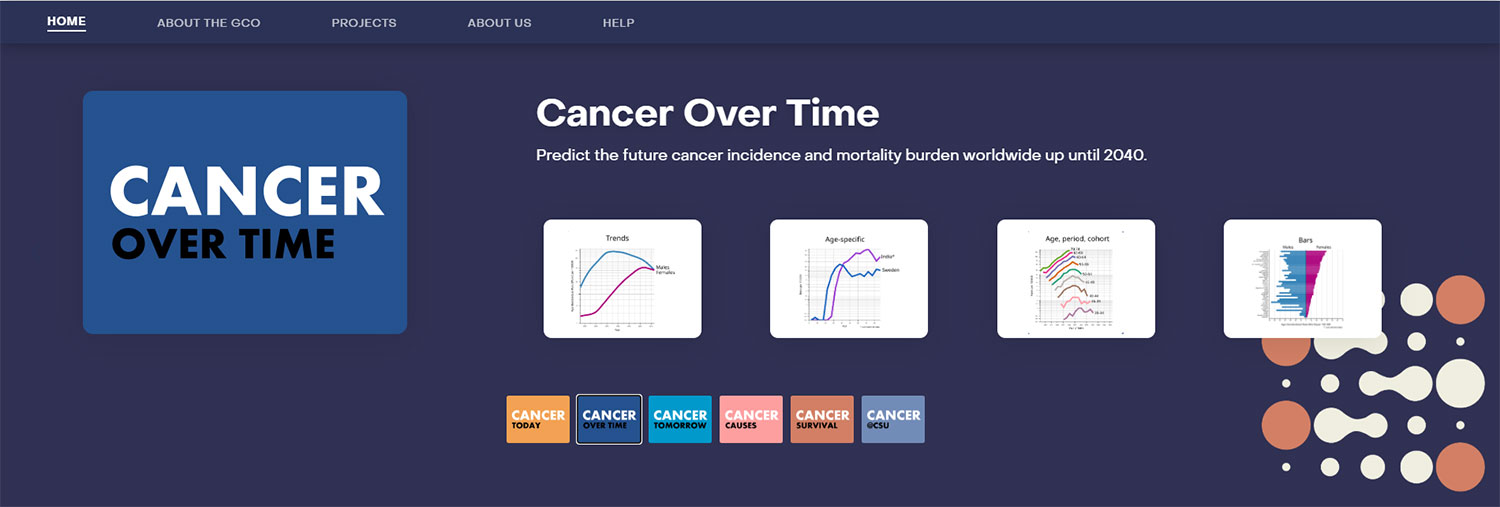Related websites
Global Cancer Observatory
The Global Cancer Observatory is an interactive web-based platform that presents global cancer indicators of direct relevance to cancer research and policy, developed via CSU’s descriptive research programme. The Global Cancer Observatory is constantly evolving; at present there are six subsites:
-
Cancer Today
Showcases the global burden today based on the national GLOBOCAN estimates of incidence, mortality, and prevalence, which are derived using available data from cancer registries and national vital statistics offices worldwide.
- Cancer Tomorrow
Provides predictions of the future cancer burden worldwide up to 2050, based on the current set of GLOBOCAN estimates and various projection scenarios.
- Cancer Causes
Provides estimates of the global burden of cancer attributable to specific major causes of cancer.
- Cancer Survival
Provides comparable survival estimates in different populations, based on CSU’s continuing cancer survival research work.
- Cancer Over Time
Provides detailed analyses of cancer incidence and mortality trends nationally.
- Cancer@CSU
Provides a comprehensive overview of the online tools, databases, and related projects available online.
Cancer survival estimates
A major component of CSU’s research work involves the development of comparable population-based cancer survival estimates for benchmarking purposes. Two long-standing and ongoing international projects seek to assist planners in assessing the effectiveness of cancer services in different settings:
- Cancer Survival in High-Income Countries (SURVMARK)
This website benchmarks cancer survival, alongside incidence and mortality, across major cancer types in the countries that are part of the International Cancer Benchmarking Partnership (ICBP). The project, now entering its third phase (SURVMARK-3), seeks to leverage experience and expertise to bring cutting-edge techniques to the collection, analysis, interpretation, and dissemination of cancer-specific survival benchmarking data across ICBP countries and jurisdictions.
- Cancer Survival in Countries in Transition (SURVCAN)
This global survival benchmarking study seeks to produce comparable survival statistics in countries in transition. SURVCAN-3 represents a major expansion of the coverage area and extent of collaboration with PBCRs worldwide. In addition to benchmarking survival, SURVCAN aims to enhance local capacity in these settings to collect follow-up data and perform survival analyses in-house.
Other databases
- Cancer Incidence in Five Continents (CI5)
This series of volumes, published every 5 years in collaboration with the International Association of Cancer Registries (IACR), continues to be reference source of quality-assured data on the international incidence of cancer as collected by PBCRs. CI5 is now in its 12th volume. The CI5 databases representing each volume online provide access to detailed information on cancer-specific incidence as recorded by cancer registries (subnational or national) worldwide in different formats, including access to the current volume (Volume XII).
- NORDCAN 2.0
This website presents comparable and up-to-date cancer statistics for Denmark, Finland, Iceland, Norway, Sweden, the Faroe Islands, and Greenland.
Childhood cancer
- Cancer Risk in Childhood Cancer Survivors (CRICCS)
A collaborative population-based project funded by Children with Cancer UK. The primary aims are to estimate the prevalence of childhood cancer survivors in Europe and to quantify the risk of second primary neoplasms in survivors of childhood cancer in Europe.
- International Incidence of Childhood Cancer (IICC)
The IICC series compiles recorded data on the incidence of cancer in children around the world, and it is currently available in its third iteration (IICC-3).
- Automated Childhood Cancer Information System (ACCIS)
An authoritative source of data on cancer incidence and survival of children and adolescents in Europe. The primary aim is to disseminate comprehensive information about the occurrence and outcome of various cancers in young people in Europe, to stimulate research and inform public health policies.
Cancer Inequalities
- Cancer Inequalities
The work is conducted within the IARC Cancer Inequalities Team, and it is structured across three main programmatic areas: (i) global development, (ii) social inequalities, and (iii) health-care inefficiencies. Cancer incidence and mortality are not equally distributed across countries and individuals. The research programme within CSU aims to characterize social inequalities in cancer within the wider context of global transitions and the profile of cancer while also considering the underlying mechanisms and the inefficiencies in the equitable provision of health-care services.
- EU-CanIneq: Mapping Socioeconomic Inequalities in Cancer Mortality across European Countries
The EU-CanIneq project is a key component of the European Cancer Inequalities Registry (ECIR), which is led jointly by DG SANTE, the Joint Research Centre (JRC), the Organisation for Economic Co-operation and Development (OECD), and IARC. The goal of the project is to produce indicators of socioeconomic inequalities in cancer mortality across the 27 EU countries plus Iceland and Norway.
Registry websites
- International Association of Cancer Registries (IACR)
CSU provides the Secretariat for the IACR and hosts the website of this professional society, which is dedicated to fostering the aims and activities of cancer registries worldwide.
- Global Initiative for Cancer Registry Development (GICR)
This website provides details of the activities of the GICR, which seeks to assist countries in transition in building capacity to collect, synthesize, and disseminate quality-assured cancer data, so that targeted actions can be taken to tackle the rising cancer burden. It also provides various resources for cancer registries, including webinars, manuals, and standard operating procedures.

